Corals, contaminants, and climate change
Bleaching. This complicated and foreboding term now lurks around every conversation about coral reefs. Impacted heavily by climate change and associated warming oceans, coral reefs experience bleaching when the algae that live in their tissues and contribute vitally to their growth are expelled, causing the corals to lose their color, and possibly their lives.
Closely related to anemones and jellyfish, corals can obtain algae from the environment and put them in their tissues. “Corals live like a little diaphanous greenhouse, where the algae are safe and consume the waste products from coral. In exchange, the algae give oxygen, sugars, and other nutrients back to the coral animal,” Callum Backstrom, a PhD student at SAFS, describes. The mutualism between coral and algae allows corals, otherwise diminutive, gelatinous animals, to make the massive, multi-ton skeletal structures composing reefs. Home to about 25% of all marine life and hosting up to half of all marine fish at some point in their life cycle, coral reefs are incredibly important for humans too, reducing up to 85% of wave height and storm energy on the coastlines they border.
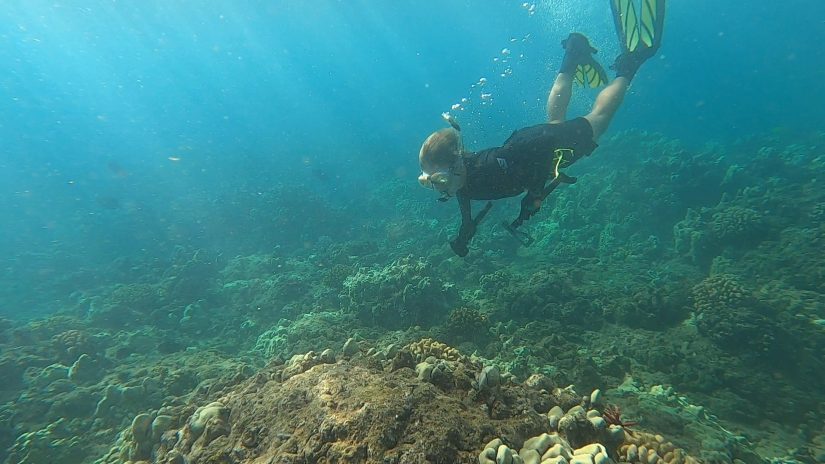
A member of Jacqueline Padilla-Gamiño’s lab group, Callum is interested in the resilience of certain corals to bleaching. “I’m asking questions like why are some corals more resilient? And for the ones that do survive, how could coral reproduction be compromised after a bleaching event?” Callum shared. A primary cause of bleaching is ocean warming, which causes the algae to go into “overdrive,” producing toxic forms of oxygen that in turn stress the coral into expelling their primary food source. Bleached corals may resorb their reproductive cells for nutrition and otherwise forego reproduction altogether to survive starvation until they can regain their photosynthetic algae.
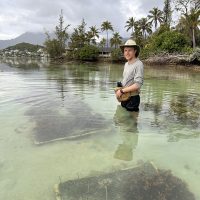
More resilient corals that resist bleaching may contain strains of heat-tolerant algae, but, as Callum explains, there are issues associated with this: “When oceans are cooler and times are good, these resilient types of algae are not generally the best partners for the coral. They aren’t as efficient, or don’t provide as much energy to the coral as less resilient algal strains and therefore can cause the coral to be outcompeted by other coral colonies in their environment.” Another way that more resilient corals combat bleaching is by increasing their rate of feeding on zooplankton and detritus from the water column; however, more feeding could mean these corals are prone to consume more pollutants, such as microplastics and heavy metals, in the marine environment.
The effects of these pollutants are a specific area of interest for Callum: do bleached corals accumulate more pollutants from a less photosynthetic, more feeding-driven diet, and could these acquired pollutants damage the health or reproductive success of bleached corals well after recovery of their symbiotic algae?
Some pollutants, like microplastics, are synthetically produced by humans and therefore have a clear origin as environmental contaminants. One difficulty faced when asking questions about elemental contaminants like metals is that many metals are used in low concentrations as essential trace nutrients for healthy coral function. But most studies on this topic focus on vertebrates, and very little is known about contaminants in organisms without a backbone, such as corals. “So, a key piece of this puzzle is to find out what the normal concentrations are for corals, what kind of contaminants are building up and at what level, and is this happening when they’re stressed and eating more?” Callum said.

The breakdown in the symbiosis between corals and their algae helps to answer this question. Callum has extensively studied the mutualistic exchange of resources between corals and their algae – last year, he published his work investigating the role of photosynthesis in mesophotic corals from deep, almost pitch-black depths of the ocean in the Proceedings of the Royal Society.

This gave him a basis to hypothesize about how bleaching events can show us what is essential to that mutualism. “When a coral undergoes a bleaching event and dumps out all its algae, when it gets them back, the metals found in the newer algal cells could be the ones important for normal cell function, as opposed to lifelong contaminants. I have found that algal cells packed inside coral eggs prior to reproduction have different, often lower metal concentrations than those in the adult coral, which could corroborate a baseline level of “healthy,” essential trace levels of these metals. Everything else above these baselines, or that does not get transferred to the offspring, then has a much more compelling basis to be called a contaminant,” Callum explains. An example of an elevated metal that Callum has seen in the eggs of coral is arsenic. Used in herbicides in Hawaii’s agriculture, atomic pollutants such as arsenic don’t degrade, meaning arsenic released into the environment 100 years ago remains in the system. “And now we might be seeing it work its way through corals and other marine organisms,” Callum shares.
To study these issues, Callum conducts his fieldwork at the Hawaiʻi Institute of Marine Biology on Moku O Loʻe (Coconut Island), off Oʻahu. There, for projects spanning the last three years, Callum has collected and grown corals on the reef, stained corals to track their growth rates, and even brought them to large tanks on the shoreline for months at a time to simulate bleaching events, run feeding experiments, and collect coral eggs and sperm during spawning events. His work in the summer of 2024 investigating the effects of the Lahaina fires of summer 2023 on corals in Maui concluded various studies of the bioaccumulation of metals and microplastics in corals, which will serve as the foundation of his PhD dissertation.

Callum hopes that his work studying bleaching and pollution events in coral reefs will help us understand and predict the needs of corals into the future. More immediately, his pollution-oriented research will help isolate specific metals to be targeted by remediation efforts across Oʻahu and Maui, especially in the wake of the Lahaina fires. For example, certain plants like Chinese Brake Fern could be integrated into coastal zones to remove arsenic from contaminated soils that is leaching into Hawaiian reefs. However, by characterizing the exchange of trace metal nutrients between corals and their symbiotic algae, and the breakdown of this exchange during bleaching, Callum can further identify metals that could help boost coral resilience. Emerging studies are testing the potential for trace metal seeding to boost thermal resilience in marine algal populations; Callum believes his work can help these applications expand to corals as well.
In addition to various SAFS course guest lectures and department symposia, Callum has been featured as a speaker at the International Coral Reef Symposium in Bremen, Germany in 2022, the Western Society of Naturalists in Monterey Bay, CA, and at a microplastics research workshop at the Seattle Aquarium, both in 2023. For his talk describing his heavy metals research at the annual meeting of the Society of Integrative and Comparative Biology in Seattle in 2024, he earned the Mary Rice Award for Best Student Presentation. Callum mentors six undergraduate students across various departments, who have been instrumental in his research toward his PhD dissertation. He also leads weekly lab meetings with his undergraduate research students to discuss topical papers and/or share experiences and ideas related to their work as a team. These meetings have also provided opportunities for feedback among coral team students as they communicate their findings across venues throughout the college, such as undergraduate research symposia. This year, Callum has been recognized as one of the Husky 100 for his PhD research and undergraduate mentorship at the UW.
- Some members of Callum’s undergraduate research team (from l to r: Kat Arnett, Eliana Shankar, Edith Holmsten, Maricor Sefe, and Andrew Vasey). These students have helped with various projects including measuring coral growth rates, counting microplastics and zooplankton consumed by experimental coral fragments, and removing coral tissues for metal toxicology analyses.
- Callum with one of his research students, Eliana Shankar, a member of the College of the Environment’s Identity, Belonging, and Inquiry in Science (IBIS) program, presenting her measurements of male and female sex cell development in Hawaiian corals at the UW Undergraduate Research Symposium in the spring of 2024.
Most days, you can find Callum tinkering with corals in the Fishery Sciences Building or preparing live-organism demonstrations in the class laboratories of the Fisheries Teaching & Research Building. You can catch him and his undergraduate team displaying live invertebrates and plastic pollution-catching devices at the upcoming Aquatic Sciences Open House on 17 May!
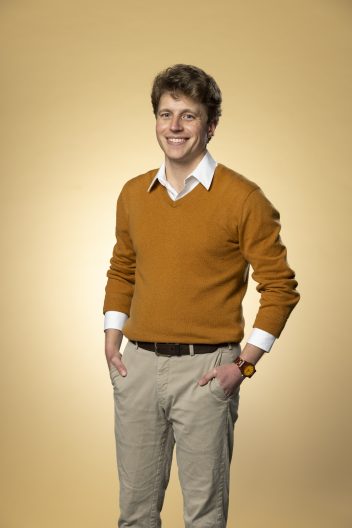
New Major: BS in Aquatic Conservation & Ecology (ACE)
Coming to the UW in Autumn 2025! We’re excited to announce a new undergraduate degree in the School of Aquatic & Fishery Sciences (SAFS): Bachelor of Science in Aquatic Conservation and Ecology (ACE)
The Aquatic Conservation and Ecology (ACE) degree is about the ecology of aquatic organisms, the rivers, lakes, and oceans in which they live, and how we conserve them for the benefit of people and the planet. This degree integrates the disciplines of ecology, evolution, and quantitative sciences and applies these principles to contemporary conservation and natural resource management issues.
Graduates of the ACE major are uniquely qualified for careers in universities and other educational settings, management agencies at the local to international levels, environmental consulting, and non-profit organizations.
Learn by doing
The ACE degree equips students with knowledge and skills for lifelong learning about the ecology and evolution of aquatic species and ecosystems, and how we sustain them for generations to come.
Central to the degree is an integrative approach to developing communication, quantitative reasoning, and data science skills that careers in this field increasingly demand.
Learning outcomes
- Understand the ecological processes that influence aquatic biodiversity, and apply that knowledge to well-known ecosystems and species
- Implement the tools and methods used in ecology, conservation, and resource management
- Diagnose conservation and natural resource outcomes based on the inter-relations of natural, social and governance systems
- Apply mathematical and data science methods to the study of aquatic ecology and conservation science
Recommended Preparation
First Year Students: Composition, calculus, chemistry, biology, FISH 200 or FISH 250
Second Year Students: Statistics, ACE intro coursework, Communicating Science coursework, College of Environment’s General Education requirements
Major Requirements
Foundation Math & Science – 39-47 credits:
- Quantitative (Calculus & Statistics) 15 credits
- General & Organic Chemistry 9-17 credits
- Biology & Physiology 15 credits
ACE Introduction – 13-15 credits:
- Life in Water – choose one:
- FISH 200 Freshwater Ecology & Conservation
- FISH 250 Marine Biology
- People in the Environment – choose one:
- FISH 230 Economics of Fisheries & Oceans
- ANTH 210 Intro to Environmental Anthropology
- ESRM 235 Intro to Environmental Economics
- Connecting to Career Pathways – choose one:
- FISH 300 Exploring Opportunities in Aquatic Science
- MARBIO 301 Current Topics in Marine Biology
- Programming & Data Science – choose one:
- Q SCI 256 Intro to Data Science Methods
- CSE 160 Data Programming
Skills – 7-8 credits:
- Communicating Science – choose one:
- MARBIO 305 Scientific Writing
- FISH 290 Scientific Writing
- Data Analysis & Modeling for Ecology and Conservation – choose one:
- Q SCI 483 Statistical Inference in Applied Research II (has prereq: Q SCI 482)
- FISH 454 Intro to Quantitative Ecology
ACE Core Knowledge Areas – 15 credits:
- FISH 323 Conservation & Management of Aquatic Resources
- FISH 312 Aquatic Ecology
- Genetics – choose one:
- FISH 340 Genetics & Molecular Ecology
- FISH 370 Marine Evolutionary Biology
Advanced Topics – min. 20 credits
Upper-division electives, from approved list of courses:
- Aquatic Ecology
- e.g. Parasite Ecology, Watershed Ecology, Salmonid Behavior
- Aquatic Conservation & Resource Management
- e.g. Stream/Watershed Restoration, Sustainable Aquaculture
- Quantitative Analysis, Modeling, Applied Data Wrangling
- e.g. Quantitative Conservation & Management
- Practicum Option – Independent Study/Research
- Recommended for students who want to pursue advanced degrees
For More Information:
Students will be able to declare the new ACE major beginning in Autumn 2025. In the meantime, if you would like to learn more about the major, contact our undergraduate adviser:
Screening of Scale of Change, a salmon documentary
Join SAFS for the screening of a new documentary, Scale of Change, on 8 May at 5:30pm-7pm, organized by the UW Student Subunit of the American Fisheries Society. The screening will take place after the SAFS Departmental Seminar and TGIT, in FSH 102.
Information about the Scale of Change documentary
In the upcoming documentary Scale of Change, we explore how individual actions, no matter how small, can lead to monumental transformations for the Atlantic salmon. One person restores a river system. Another removes a dam. Each action is a drop in the bucket, but together, those drops fill it—creating a ripple effect of change that, while not always immediately visible, holds the power to shape the future. If we believe in that shared vision, and have hope, we can make a meaningful difference.
Parasite video featuring Chelsea Wood, nominated for an Emmy
The 2024 Northwest Emmy Nominees for Category 24, Environment/Science – Short Form Content – includes a video featuring SAFS Professor, Chelsea Wood, and her work on parasites. The video, produced by Grist, explores why nature can’t run without parasites, and what happens when they start to disappear.
The video was part of a video series profiling the science and scientists behind some of the environment’s most unexpected research.
Watch the video
Bringing to life the story of Pacific salmon and their recovery challenges
In a StoryMap bringing to life the challenges faced by Pacific salmon, SAFS graduate student, Amirah Casey, dives into the role of urban stormwater runoff and climate change in hindering salmon recovery.
Pacific salmon and Steelhead are vital to many parts of life in the Pacific Northwest, and across western North America. From recreational and commercial fisheries that benefit humans, to providing a food source for birds and marine mammals, while also being central to the cultures of Indigenous Peoples, these species are integral in this part of the world. Historically low abundances led to research which revealed a unique threat to them: polluted stormwater runoff and the presence of the chemical 6PPD-q, which comes from when the chemical 6PPD in vehicle tires reacts ozone in the air.
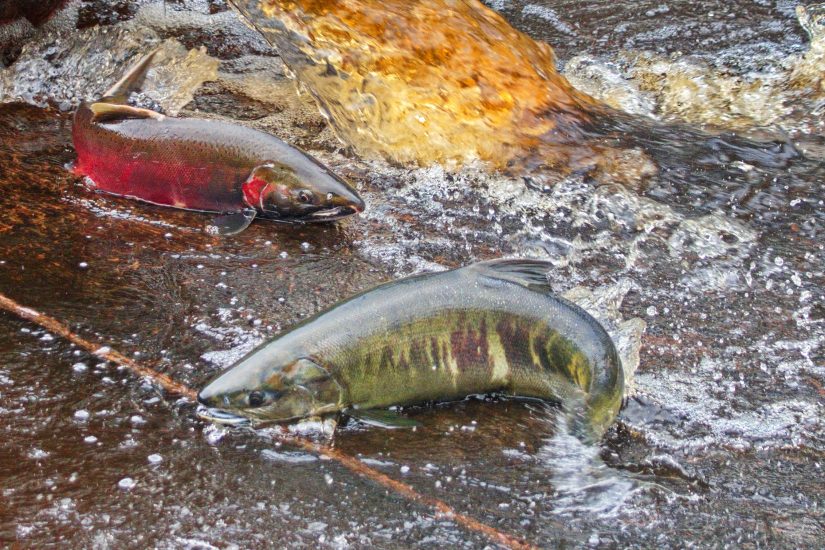
“I have always been interested in how humans impact the environment, and my interest in urbanization and climate change really blossomed in high school,” Amirah shared. “My jumpstart into research began when I took the first ever class as part of the Marine and Coastal Science cohort at Western Washington University (WWU), taught by Dr. Jim Cooper. He taught us about POP’s (persistent organic pollutants) and I was soon working in his lab with chemicals like PCBs and PBDEs.”
After joining the SAFS graduate program, Amirah became a member of the Applied Ecology Lab, advised by Dr. Mark Scheuerell, and reached out to the program manager of the NOAA Ecotox team—Dr. Nat Scholz—to see if there were any opportunities to collaborate. “I told him my two biggest interests were the effects of urbanization and climate change on our natural systems and how I wanted to be a part of the solution. That is when he said: “Oh yeah, you’re one of us” and we have been working together ever since,” Amirah said.
Amirah’s collaborators at the NOAA Northwest Fisheries Science Center (NWFSC) Ecotoxicology Program had an old StoryMap on their website and the EPA website, dating from before 6PPD-q was discovered. Amirah decided she would take on the project of revamping the StoryMap with updated science and engaging elements to share more widely about the stressors that Pacific salmon are facing. “The impacts of stormwater runoff on species like Coho salmon are undeniable,” Amirah said. “Up to 90% mortalities in urban watersheds after storm events is completely unsustainable if there is any hope of recovering these species, and that’s why I became so interested in how these two stressors (urbanization and climate change) impact Pacific salmon.”
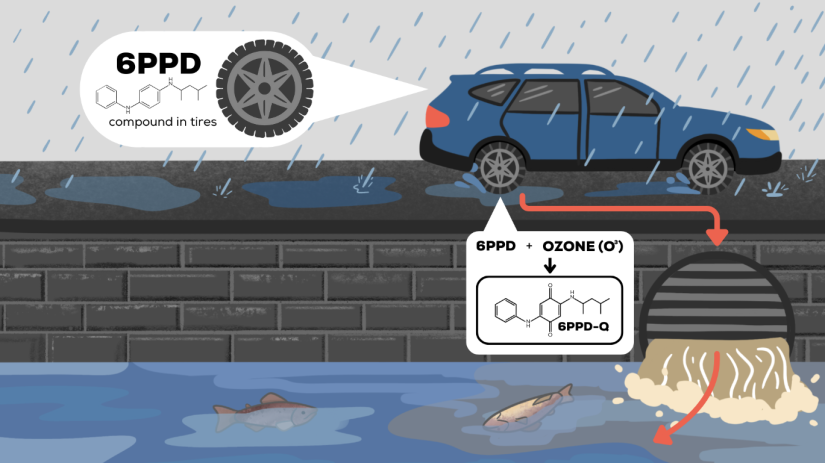
Two big elements were new in Amirah’s version of the StoryMap. One was updated information, compiled over decades of research on this topic by the NOAA Ecotox team. “My role in this project was to sort through all the folders of images and videos collected by NOAA and select which would tell the best story, and likewise go through linked resources such as articles, YouTube videos and peer-reviewed literature that would support readers looking for more information,” Amirah said. “As someone who has worked on stormwater for so many years, the insights and narratives provided by Nat Scholz were invaluable in telling this story.”
The second new element were original graphics, videos and photographs, created and taken by Samantha-Lynn Martinez, a recent graduate of the UW Marine Biology program. “I met with Samantha-Lynn during a SEAS outreach event, and she had shared some of her work with salmon and stormwater, and a lightbulb went off in my head,” Amirah shared. “I really wanted to be able to work with her to take images and videos, and create graphics for the StoryMap—and get paid for her work—so that’s when I applied for the Future Rivers support funding and was able to hire Samantha-Lynn for her amazing graphic design and photography.”
Check out the easily accessible and engaging StoryMap, “Pacific Salmon at a Crossroads”, to learn more about the story of urban stormwater runoff and climate change, and to dive in to more resources and open-source papers on the subject.
UW Aquatic Sciences Open House back on 17 May
New molecular tools for reef conservation and climate resilience
New research has revealed that certain protein particles distinguish resilient corals from those that succumb to bleaching, offering new molecular tools for reef conservation and climate resilience. “Some corals are very resilient and very robust. To improve reef restoration efforts, we performed studies to determine how to identify and select resilient coral for propagation purposes and to assure they would have offspring,” said Brook L. Nunn, research associate professor in the Department of Genome Sciences at the University of Washington School of Medicine.
Part of the research team was SAFS Associate Professor, Jacqueline Padilla-Gamiño. “The work provides a blueprint for identifying corals most likely to survive future bleaching events, offering critical insights to predict and enhance reef resilience in a rapidly warming world,” she said.

